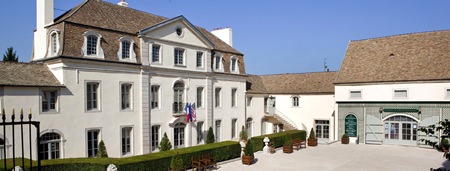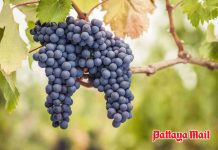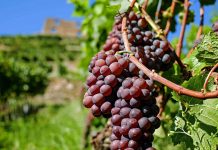You might be interested to know that most of the everyday wines of France come to you through the hands of either a cooperative or a négociant. Of course, you might not be interested in the slightest but I feel compelled to explain, because both the wines this week come from négociants. The French word négociant means a wine broker who buys grapes or wines in various states of completion then makes and bottles the finished product for the consumer. In the case of grapes or grape must (which is freshly pressed grape juice containing the skins, seeds, and stems of the fruit) the négociant deals with the remainder of the winemaking process. If a négociant buys already fermented wine in barrels or in bulk containers, it may decide to age the wine for a bit longer, blend in other wines or simply bottle it and sell the stuff as it is. Many small wine-makers can’t afford expensive wine-making equipment and bottling machinery, so it makes a great deal of sense for a négociant to do the work for them.
The finished wine is nearly always sold under the name of the négociant and very often under some kind of trade name. Those that contain the word “château” are very common, whether or not the château actually exists. This is not as surprising as it seems, because the majestically-named Fédération des Syndicats des Grands Vins de Bordeaux allows companies there to sell identical wines under different and totally fictitious châteaux names.
 The Bouchard HQ in Beaune dates from 1743.
The Bouchard HQ in Beaune dates from 1743.
One of France’s biggest and most successful négociants is Bouchard Aîné & Fils. It’s one of the oldest too, boasting a history of over two centuries. Michel Bouchard settled in Burgundy in 1731 and had a flourishing enterprise in the fabric trade before becoming a wine broker. Perhaps there was more money in wine than there was in wool. Over the generations, the company learned to work closely with local wine-growers with a shared quest for perfection in quality and authenticity of style. Today you can find Bouchard wines all over the world and they stand as reliable symbols of quality.
Bouchard Aîné & Fils Pinot Noir 2012 (red), France (Bt. 794 @ Villa and others)
If I had any choice in the matter, I’d be happy to drink Pinot Noir (PEE-noh NWAHR) most of the time, especially the voluptuous earthy reds of Burgundy, which is the grape’s spiritual home. It’s one of the great wine grapes of the world, often lighter and less tannic that Cabernet Sauvignon and Merlot. The finest Pinot Noirs shine with the aromas of cherries and plums, damp earth and mushrooms. The grapes can be tricky to grow, but the best of the wines are sensuous and aromatic and have a silky mouth-feel. You may be surprised to know that New Zealand has a reputation for producing some splendid Pinots, predominantly in the cooler southerly regions.
This wine hails from the South of France and has aromas of cherries with a dash of citrus and mint. It has a smooth beguiling mouth-feel with soft supple tannins, cherries and dark fruit on the taste and a hint of oaky wood. There’s a spicy, herbal earthiness with a long, dry fruity finish. I thought I could just pick up a hint of dark chocolate too.
The wine is as dry as they come, but there’s plenty of fruit on the taste, giving the illusion of a hint of sweetness. It’s a very pleasing, fairly full-bodied easy-drinker and with an alcohol content of 13% it would make a good food wine. Pinot Noir is usually something of an all-rounder and a good match for meats, barbeques, pizzas, light game or vegetable dishes.
Château La Paz, 2011 Bordeaux, France (red) (Bt. 1,200 – 2,200 @ various outlets)
Château La Paz is produced by a négociant called Borie-Manoux, founded in 1870 and now based in the city of Bordeaux. The company owns ten Bordeaux châteaux which include several well-known names such as Ch. Batailley and Château Trotte-Vieille. It also has close ties to the old-established London wine merchant Berry Bros. & Rudd and makes one of their top-selling brands.
The label says that the wine comes from Asques, which is a small, sleepy town lying about twenty miles north-east of Bordeaux on the right bank of the River Dordogne. If you find the expression “right bank” a bit meaningless, perhaps I should explain that the right bank of a river is on your right only when you are heading down-stream towards the sea. If you were swimming in the opposite direction, the right bank would be on your left. Or perhaps that’s obvious. Never mind, I’ll say it anyway. People often get confused about these things.
The wine is a very dark red and if you swirl it around in the glass, those little rivulets called “legs” will appear. Merlot aromas dominate because on the right bank, Merlot usually makes up the largest proportion of the blend in red wines, with lesser proportions of Cabernet Sauvignon and Cabernet Franc. The taste comes as something of a surprise because it has quite a bit more “edge” on the palate than I was expecting. It’s a very dry, medium-bodied wine with a pleasingly soft texture and a firm foundation of tannin. I’d guess that the wine was matured in stainless steel vats which are now increasingly common, because they preserve the freshness more effectively than oak barrels.
This 15% ABV wine has a longish dry finish with more flavours of tannin. There’s also a dash of acidity on the palate which makes me feel that it would show best with food. The obvious choice would be beef dishes with rich sauce but I think it would work with pasta too. I’ve been told by the importers that this wine is not yet available at local retail outlets, but you can find it at the Sofitel Bangkok and – probably a good deal cheaper – at the Anytime Café near Pattaya’s Bali Hai Pier.




